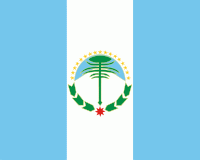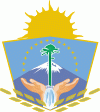Neuquén Province (Neuquén Province)
 |
 |
The Neuquén Province receives its name from the Neuquén River. The term "Neuquén" derives from the Mapudungun word "Nehuenken" meaning drafty, which the aborigines used for the river. The word (without the accentuation) is a palindrome.
Lácar Department in Neuquén Province has the southernmost known remains of maize before it was further diffused by the Inca Empire. Maize remains were found as far south as 40°19' S in Melinquina, with it being found inside pottery dated to 730 ±80 BP and 920 ±60 BP. This maize was probably brought across the Andes from Chile.
Inhabited by Tehuelches and Pehuenche, the territory was initially explored by conquistadores coming from Chile. In 1670 a Jesuit priest established in Chiloé Archipelago, Nicolás Mascardi, founded the Jesuit mission Nuestra Senora de Nahuel Huapi. The Jesuit missions lasted few years and the last mission in Neuquén was destroyed in 1717. The suppression of the Society of Jesus in 1767 halted further missionary activity.
Map - Neuquén Province (Neuquén Province)
Map
Country - Argentina
 |
 |
| Flag of Argentina | |
The earliest recorded human presence in modern-day Argentina dates back to the Paleolithic period. The Inca Empire expanded to the northwest of the country in Pre-Columbian times. The country has its roots in Spanish colonization of the region during the 16th century. Argentina rose as the successor state of the Viceroyalty of the Río de la Plata, a Spanish overseas viceroyalty founded in 1776. The declaration and fight for independence (1810–1818) was followed by an extended civil war that lasted until 1861, culminating in the country's reorganization as a federation. The country thereafter enjoyed relative peace and stability, with several waves of European immigration, mainly Italians and Spaniards, radically reshaping its cultural and demographic outlook; over 60% of the population has full or partial Italian ancestry, and Argentine culture has significant connections to Italian culture.
Currency / Language
| ISO | Currency | Symbol | Significant figures |
|---|---|---|---|
| ARS | Argentine peso | $ | 2 |
| ISO | Language |
|---|---|
| EN | English language |
| FR | French language |
| DE | German language |
| GN | Guarani language |
| IT | Italian language |
| ES | Spanish language |















